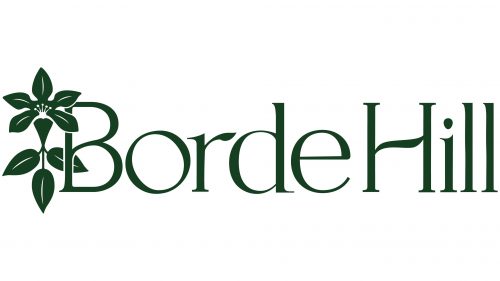Borde Hill logo perfectly captures the essence of an English garden, with its remarkable incorporation of plant motifs. First and foremost, a flower is next to the “B.” The petals and leaves are so similar in shape and color that they are nearly indistinguishable. The blooming bud comprises five petals with stamens visible in the negative space. Below, three leaves are drawn. Wavy lines in certain letters like “B,” “r,” and “H” resemble sinuous stems. All elements are rendered in a dark green hue.
The flower is a central feature, consisting of five petals. The number five has long been associated with balance and harmony. The petals and leaves, being so similar, reflect the notion of unity and continuity. These characteristics resonate with the garden’s aim to provide an environment of harmony and balance for both plant life and visitors.
Stamens are visible in the negative space between the petals, offering an added layer of detail. This meticulous attention to tiny elements mirrors the garden’s focus on nurturing each plant, each leaf, and each flower, down to the smallest elements that make up the vibrant and diverse setting it creates for the flora.
The use of dark green for all elements. This hue universally signifies nature, growth, and tranquility. It also encapsulates the lushness that the garden aims to offer its visitors. Dark green encapsulates the peace and relaxation many seek when entering such a natural space.
The lines forming the letters “B,” “r,” and “H” in the garden’s name mimic the curves of plant stems. This serves as a visual cue to the garden’s organic, flowing design, which intends to keep visitors engaged as they move from one verdant area to another.
The trio of leaves drawn at the bottom further enhances the garden’s promise of lush foliage. Leaves symbolize growth and life; their trio presentation often signifies past, present, and future. Borde Hill provides an environment where the past is honored, the present is enjoyed, and the future holds the promise of flourishing life.
Subtleties in the emblem don’t merely serve aesthetic purposes; they tell a story of balance, attention to detail, and an ode to nature. Every curve, color, and leaf intricately stitches together what the garden represents: a sanctuary of natural beauty crafted carefully over time. The logo becomes a visual mantra for what one experiences within the garden’s confines—a harmonious blend of the botanical world.
Borde Hill: Brand overview
| Founded: | 1958 |
| Founder: | Robert Stephenson Clarke |
| Headquarters: | north of Haywards Heath, West Sussex in southern England |
| Website: | bordehill.co.uk |
Nestled in West Sussex, England, Borde Hill is a sprawling estate boasting gardens that have evolved through centuries. The estate originated in the late 16th century. It was built in the Elizabethan style by Stephen Borde, a descendant of Andrew Borde, who served as a physician to King Henry VIII.
The property underwent a significant transformation in 1893 when Colonel Stephenson Robert Clarke, a British Army Officer with a deep-rooted passion for horticulture, acquired it. Clarke initiated a series of international plant discovery journeys to bring unique and rare flora to the estate. His efforts turned Borde Hill into a sanctuary for a remarkable array of trees and shrubs.
In the years following Colonel Clarke’s death in 1948, the estate remained within the family, passing through generations. His great-grandson, Andrew John Stephenson Clarke, along with his wife, Eleni, carried out the grounds stewardship of the grounds. Their contributions to the estate were recognized in 1999 when Borde Hill was honored with the Attraction of the Year award.
Today, the estate, still privately owned by the Stephenson Clarke lineage, spans an expansive 200 acres. Over a century of plant collection has yielded garden “rooms,” each dedicated to various flora, including roses, rhododendrons, and champion trees. The original Elizabethan manor remains the estate’s centerpiece, reinforcing the property’s historic roots. The estate serves as a family residence and has emerged as a sought-after destination for tourists, enchanted by its natural beauty and historical charm.






